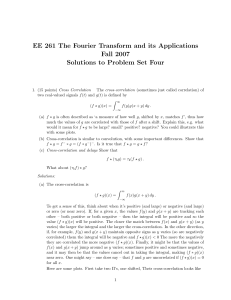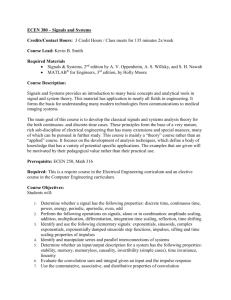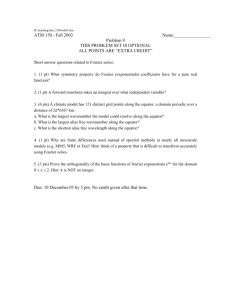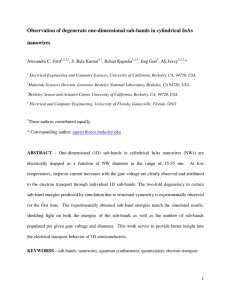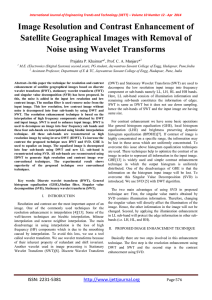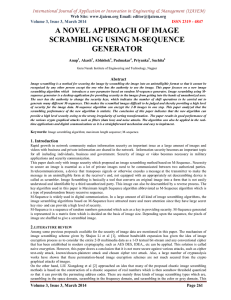EE 261 The Fourier Transform and its Applications Fall 2007
advertisement
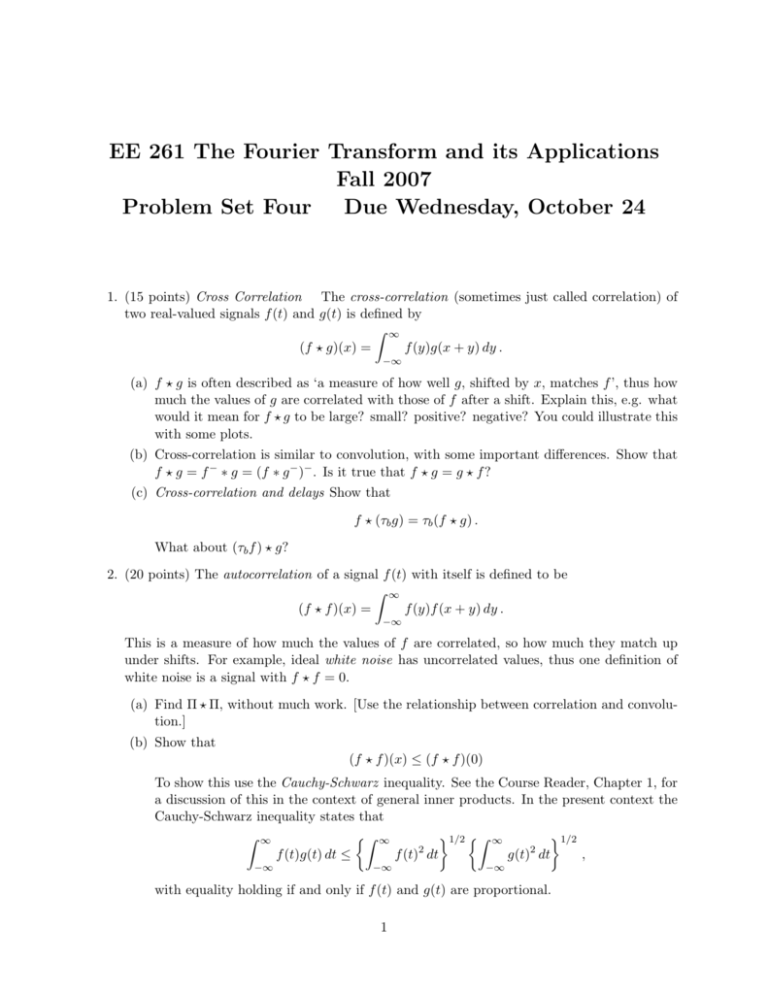
EE 261 The Fourier Transform and its Applications Fall 2007 Problem Set Four Due Wednesday, October 24 1. (15 points) Cross Correlation The cross-correlation (sometimes just called correlation) of two real-valued signals f (t) and g(t) is defined by ∞ f (y)g(x + y) dy . (f g)(x) = −∞ (a) f g is often described as ‘a measure of how well g, shifted by x, matches f ’, thus how much the values of g are correlated with those of f after a shift. Explain this, e.g. what would it mean for f g to be large? small? positive? negative? You could illustrate this with some plots. (b) Cross-correlation is similar to convolution, with some important differences. Show that f g = f − ∗ g = (f ∗ g − )− . Is it true that f g = g f ? (c) Cross-correlation and delays Show that f (τb g) = τb (f g) . What about (τb f ) g? 2. (20 points) The autocorrelation of a signal f (t) with itself is defined to be ∞ f (y)f (x + y) dy . (f f )(x) = −∞ This is a measure of how much the values of f are correlated, so how much they match up under shifts. For example, ideal white noise has uncorrelated values, thus one definition of white noise is a signal with f f = 0. (a) Find Π Π, without much work. [Use the relationship between correlation and convolution.] (b) Show that (f f )(x) ≤ (f f )(0) To show this use the Cauchy-Schwarz inequality. See the Course Reader, Chapter 1, for a discussion of this in the context of general inner products. In the present context the Cauchy-Schwarz inequality states that ∞ 1/2 ∞ 1/2 ∞ 2 2 f (t)g(t) dt ≤ f (t) dt g(t) dt , −∞ −∞ −∞ with equality holding if and only if f (t) and g(t) are proportional. 1 (c) Show that F(f f ) = |Ff |2 . This is sometimes known as the Wiener-Khintchine Theorem, though they actually proved a more general, limiting result that applies when the transform may not exist. It’s many uses include the study of noise in electronic systems. (d) Correlation and radar detection Here’s an application of the maximum value property, (f f )(t) ≤ (f f )(0), above. A radar signal f (t) is sent out, takes a time T to reach an object, and is reflected back and received by the station. In total, the signal is delayed by a time 2T , attenuated by an amount, say α, and subject to noise, say given by a function n(t). Thus the received signal, fr (t), is modeled by fr (t) = αf (t − 2T ) + n(t) = α(τ2T f )(t) + n(t) . You know f (t) and fr (t), but because of the noise you are uncertain about T , which is what you want to know to determine the distance of the object from the radar station. You also don’t know much about the noise, but one assumption that is made is that the cross-correlation of f with n is constant, (f n)(t) = C, a constant. You can compute f fr (so do that) and you can tell (in practice, given the data) where it takes its maximum, say at t0 . Find T in terms of t0 . 3. (20 points) Windowing functions In signal analysis, it is not realistic to consider a signal f (t) from −∞ < t < ∞. Instead, one considers a modified section of the signal, say from t = −1/2 to t = 1/2. The process is referred to as windowing and is achieved by multiplying the signal by a windowing function w(t). By the Convolution Theorem (applied in the frequency domain), the Fourier transform of the windowed signal, w(t)f (t) is the convolution of the Fourier transform of the original signal with the Fourier transform of the window function Fw ∗Ff . The ideal window is no window at all, i.e., it’s just the constant function 1 from −∞ to ∞, which has no effect in either the time domain (multiplying by 1) or in the frequency domain (convolving with δ). Below are three possible windowing functions. Find the Fourier transform of each and plot the log magnitude of each from −100 < s < 100. Which window is closest to the ideal window? Rectangle Window w(t) = Π(t) Triangular Window w(t) = 2Λ(2t) Hamming Window w(t) = cos2 (πt) , 0, |t| < 12 otherwise. 4. (15 points) Brownian motion: Consider particles suspended in a liquid. Let f (x, t) be the probability density function of finding a particle at a point x at time t. Using probabalistic arguments, Einstein showed that for some systems the evolution of f (x, t) is governed by a diffusion equation, ft = Dfxx , where D is the diffusion constant and the subscripts indicate partial derivatives. 2 (a) Assuming that f (x, 0) = δ(x), find f (x, t). (Your answer should depend on t). (b) Find the mean and the variance of f (x, t) (with respect to x). (c) From his calculations, Einstein found that the diffusion constant is given by D= kT , 6πηR where k is Boltzmann’s constant, T is the temperature, η is the viscosity of the fluid, and R is the size of the particles. Given your results from part (b), what can you say about the diffusion of the particles (their evolution over time) as a function of their size and of the temperature? 5. (20 points) Voice scrambling/descrambling A simple scrambling circuit for voice communications works as follows. Consider the frequency band from 0 to 4 kHz. It is a known fact that the overwhelming majority of the power spectrum of human voice is concentrated in this frequency band. One way of scrambling this frequency band is to subdivide it into 4 equal sub-bands and interchange the sub-bands according to some pre-determined key. For example, let sub-band A correspond to frequencies between 0 and 1 kHz. Then, sub-band B corresponds to frequencies between 1 and 2 kHz, sub-band C corresponds to frequencies between 2 and 3 kHz, and sub-band D corresponds to frequencies between 3 and 4 kHz. The original order of the sub-bands is ABCD. A simple scrambling technique is to interchange this order, i.e. reorder the sub-bands to BCDA or DCBA or CABD or any other pre-determined order. Call the resulting signal the scrambled signal. This scrambled signal is not comprehensible unless you know the key and can rearrange the sub-bands back into the original order. The goal of this problem is for you to design a MATLAB program that will descramble a given voice signal. You may obtain the scrambled signal (’scramble.wav’) from the course web site, http://eeclass.stanford.edu/ee261/ http://see.stanford.edu/materials/lsoftaee261/PS-4-scramble.wav in the ‘Problem Sets’ section of the Handouts. It has been scrambled in the above-described fashion by rearranging the bands ABCD into CBDA. Descramble this signal and transcribe the first and last 5 words. Turn in your code as well as your transcription. (No, this is not a test of your transcribing skills, we just want to make sure that your code works.) 3
